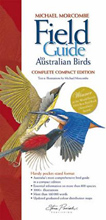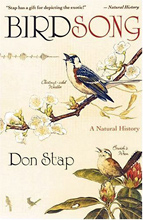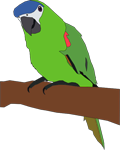Little Wattlebird
Anthochaera chrysoptera
Other Names: Little Brush Wattlebird
Family: Meliphagidae (Honeyeaters, 74 species in Australia)
Size: 26-33 cm
Distribution: Within about 50-100 km of the coast of NSW, VIC, lower QLD and Eastern SA, also Eastern TAS.
Status: Common
Habitat: Woodland, heath, scrub, likes Banksia, parks and gardens
References: Simpson and Day, Reader's Digest
The Little Wattlebird is common in parts of Sydney and many other areas. It is found in the Lower Blue Mountains but not in the Upper Blue Mountains (the Red Wattlebird is found in the Upper Mountains). It looks a lot like Red Wattlebird, but without the red flap of skin under its eye (the "wattle"), and it is a darker colour overall with more distinct white spots/stripes.
It has a very distinctive call, a bit like an old wooden cuckoo-clock (it imitates the ticking of the clock and also the cuckoo sound), which sometimes can go on for hours at a time.

Photo: Blaxland, Blue Mountains NSW

Artwork: John Gould, 'The Birds of Australia', 1848. Original Scanned Image.
Some Birdwatching Resources
|
 Field Guide to Australian Birds: Complete Compact Edition, by Michael Morcombe. Based on the above larger book. It's a while since I've seen this one. The publisher's commentary says that "This slimline, compact edition contains the same information on mainland and Tasmanian birds as his best-selling handbook, the Field Guide to Australian Birds. Features include plastic jacket, QuickFind system of colour tags and Quick Index ensure durability and ease of use in the field."
Field Guide to Australian Birds: Complete Compact Edition, by Michael Morcombe. Based on the above larger book. It's a while since I've seen this one. The publisher's commentary says that "This slimline, compact edition contains the same information on mainland and Tasmanian birds as his best-selling handbook, the Field Guide to Australian Birds. Features include plastic jacket, QuickFind system of colour tags and Quick Index ensure durability and ease of use in the field."
Purchase from Australia (Booktopia)
Purchase from Australia (Angus & Robertson) 
|
|
 Birdsong, Don Stap. From the promotional material: "Following one of the world's experts on birdsong from the woods of Martha's Vineyard to the tropical forests of Central America, Don Stap brings to life the quest to unravel an ancient mystery: Why do birds sing and what do their songs mean? We quickly discover that one question leads to another. Why does the chestnut-sided warbler sing one song before dawn and another after sunrise? Why does the brown thrasher have a repertoire of two thousand songs when the chipping sparrow has only one? And how is the hermit thrush able to sing a duet with itself, producing two sounds simultaneously to create its beautiful, flutelike melody?"
Birdsong, Don Stap. From the promotional material: "Following one of the world's experts on birdsong from the woods of Martha's Vineyard to the tropical forests of Central America, Don Stap brings to life the quest to unravel an ancient mystery: Why do birds sing and what do their songs mean? We quickly discover that one question leads to another. Why does the chestnut-sided warbler sing one song before dawn and another after sunrise? Why does the brown thrasher have a repertoire of two thousand songs when the chipping sparrow has only one? And how is the hermit thrush able to sing a duet with itself, producing two sounds simultaneously to create its beautiful, flutelike melody?"
Purchase from Australia (Booktopia)
Click here to purchase from Australia (Fishpond)
Click here to purchase from Wilderness Awareness School $24.00 USD (May not work) | See AlsoAustralian Bird Field Guides
Return to Australian Birds
Return to Site Map
Content is copyright © Survival.org.au 2005-2025 All Rights Reserved. Terms of Use. Definitely read the disclaimer before trying anything from this website, especially including the practices and skills. This website uses affiliate links – this doesn't cost you any more, but I get a commission on purchases made through the website. As an Amazon Associate I earn similarly from qualifying purchases.
|





